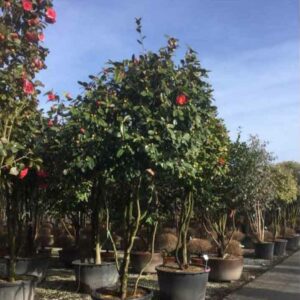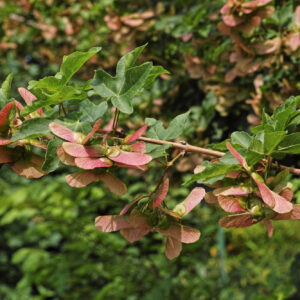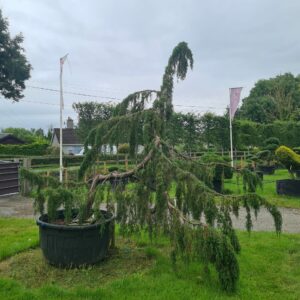Cornus Controversa / Wedding Cake Tree
£280.00
Description
Quick Facts
- Common Name: Wedding Cake Tree, Giant Dogwood, Table Dogwood
- Botanical Name: Cornus controversa
- Plant Type: Deciduous tree
- Mature Height: 8-12m
- Mature Spread: 6-10m
- Flowering Period: May to June
- Flower Colour: Creamy-white flowers in flat clusters
- Foliage: Ovate leaves, bright green turning red-purple in autumn
- Hardiness: RHS H6 (hardy)
- Soil Requirements: Moist, well-drained, fertile, neutral to slightly acidic
- Aspect: Full sun to partial shade
- Maintenance: Low
Description
Experience the breathtaking elegance of Cornus controversa, the spectacular Wedding Cake Tree that brings exceptional architectural presence, distinctive tiered form, and year-round beauty with its remarkable horizontal branching structure. This outstanding ornamental tree offers extraordinary qualities—distinctive horizontal branches arranged in elegant tiers that create a stunning layered, wedding cake-like silhouette unlike any other tree, masses of creamy-white flowers held in flat clusters measuring 10-15cm across that cover the tiered branches in late spring creating spectacular floral displays, attractive bright green ovate leaves that provide fresh summer foliage before transforming into beautiful shades of red-purple in autumn, and striking architectural form that provides exceptional winter structure when the tiered branching pattern is fully revealed, making this one of the most distinctive and architecturally stunning trees for creating dramatic focal points, oriental elegance, and four-season interest.
Throughout spring and summer, this captivating tree displays its characteristic bright green ovate leaves measuring 8-15cm long with distinctive parallel veins that create elegant texture. The leaves are arranged alternately along the branches—unusual for dogwoods which typically have opposite leaves, hence the name ‘controversa’ meaning controversial or disputed. But the tree’s crowning glory is its extraordinary branching structure—the branches grow in distinct horizontal tiers, one above the other, creating a stunning layered effect that resembles a multi-tiered wedding cake or pagoda. This architectural form is present year-round but is most dramatic in winter when the structure is fully visible. In late spring to early summer, the tree becomes adorned with masses of tiny creamy-white flowers held in large, flat-topped clusters (corymbs) measuring 10-15cm across that sit elegantly on top of the horizontal branches, creating spectacular floral displays. In autumn, the foliage transforms into beautiful shades of red-purple and burgundy, and small blue-black berries develop providing food for birds. The smooth grey bark adds subtle winter interest.
Native to China, Japan, Korea, and the Himalayas, Cornus controversa is the largest of the dogwood species and the only one with alternate leaves. The common name ‘Wedding Cake Tree’ perfectly describes the distinctive tiered branching structure. Hardy and adaptable once established, this tree thrives in British conditions when given appropriate shelter from harsh winds, preferring cool, moist conditions and fertile soil. Slower-growing than many trees but worth the wait—the architectural form develops gradually over years, becoming more spectacular with age. Requires space to develop its characteristic spreading, tiered form to full effect.
Create stunning compositions by planting as magnificent specimen trees in lawns, prominent positions, or open spaces where the extraordinary tiered form can be fully appreciated from all angles. Exceptional in oriental-style gardens, contemporary landscapes, or as architectural focal points where the distinctive structure creates dramatic impact. Works beautifully positioned where the horizontal branches can be viewed against sky or dark evergreen backgrounds that enhance the layered silhouette. Perfect for large gardens, estates, or parks where there is space for the tree to develop its full spreading form. Plant where visible from the house to enjoy the spectacular structure year-round, particularly stunning in winter when snow or frost outlines the horizontal branches.
Caragh Garden Notebook
Planting: Space trees 10-12m apart if planting multiples, or allow 12-15m for specimen placement to accommodate the mature spread—this tree needs space to develop its characteristic tiered form. Plant container-grown specimens year-round, though autumn or early spring is ideal. Dig holes twice the width of the root ball and incorporate generous amounts of organic matter. Plant at the same depth as the container. Stake for the first 3-5 years. Water thoroughly and mulch generously around the base. Choose sheltered positions protected from harsh winds and with space for the spreading, tiered branches to develop fully.
Soil Preparation: Thrives in moist, well-drained, fertile soil with pH 6.0-7.0. Prefers neutral to slightly acidic, humus-rich, moisture-retentive conditions enriched with generous amounts of organic matter. Dislikes waterlogged, very dry, shallow chalky, or strongly alkaline soils. Requires excellent drainage whilst maintaining consistent moisture—does not tolerate drought. Best growth and flowering occur in full sun to partial shade with shelter from harsh winds, consistent soil moisture, and fertile conditions. Prefers cool, moist climates.
Container Growing: Not suitable for long-term container growing due to size, spreading habit, and need for space to develop the characteristic tiered form. Young specimens can be grown temporarily in very large containers (minimum 80cm diameter) using soil-based compost enriched with organic matter for a few years, but should be planted out for best long-term health and to allow the spectacular architectural form to develop fully.
Seasonal Care: Requires minimal pruning—the naturally tiered, horizontal branching structure develops without intervention and should not be pruned as this destroys the characteristic form. Remove only dead, damaged, or diseased branches in late winter when dormant. Never prune to shape or control size—this tree needs space to develop naturally. Apply slow-release balanced fertiliser in early spring. Mulch annually with generous amounts of organic matter or composted bark to retain moisture and maintain soil fertility. Water during dry spells, especially in the first 5-7 years until established—consistent moisture is essential. Generally pest and disease resistant.
Propagation: Can be grown from seed collected from ripe berries in autumn, though seedlings take many years to reach flowering size and develop the characteristic tiered form (10-15 years). Sow fresh seed in autumn in pots outdoors—germination can be slow and erratic. Professional propagation is also by softwood or semi-hardwood cuttings in summer with rooting hormone, though success is variable. Layering is possible. Home gardeners seeking specimens with the characteristic form within reasonable timeframes should purchase nursery-grown plants.
This architectural beauty is absolutely magnificent—those distinctive horizontal tiers create such stunning, sculptural presence unlike any other tree! The wedding cake silhouette is breathtaking year-round, and those masses of creamy-white flowers covering the tiered branches in spring are spectacular. Beautiful autumn colour, elegant form, and that winter structure is pure drama. Needs space but absolutely worth it—a true garden masterpiece!






